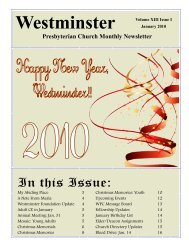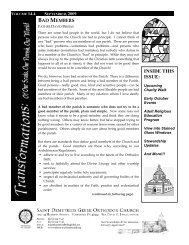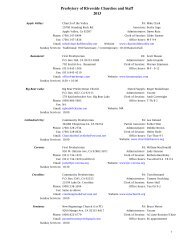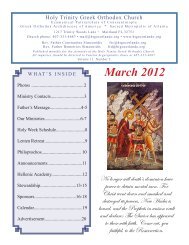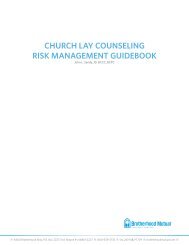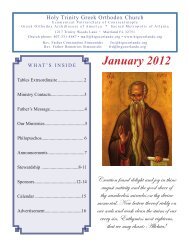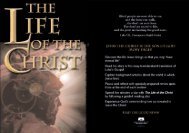OSIS? 2.0.1 User's Manual - Web services are running on AMBIB
OSIS? 2.0.1 User's Manual - Web services are running on AMBIB
OSIS? 2.0.1 User's Manual - Web services are running on AMBIB
You also want an ePaper? Increase the reach of your titles
YUMPU automatically turns print PDFs into web optimized ePapers that Google loves.
7.3.6. language<br />
A language element must be provided for each language used substantially in a work.<br />
The language may be specified using an ISO 639 or ISO 639-2, or SIL Ethnologue codes.<br />
The type attribute must be set to IANA, IETF, ISO-639-1, ISO-639-2, ISO-639-2-B,<br />
ISO-639-2-T, LINGUIST, or SIL. In the r<str<strong>on</strong>g>are</str<strong>on</strong>g> case that n<strong>on</strong>e of these is sufficient, a<br />
prose descripti<strong>on</strong> should be inserted in the element and the type attribute set to other.<br />
7.3.7. type<br />
The nature or genre of the c<strong>on</strong>tent of the resource. This element includes terms describing<br />
general categories, functi<strong>on</strong>s, genres, or aggregati<strong>on</strong> levels for c<strong>on</strong>tent. Dublin Core's<br />
recommended best practice is to select a value from a c<strong>on</strong>trolled vocabulary (for<br />
example, the DCMI Type Vocabulary -- see http://dublincore.org/documents/dcmi-typevocabulary/).<br />
<str<strong>on</strong>g>OSIS</str<strong>on</strong>g> does not provide such a c<strong>on</strong>trolled vocabulary at this time. If you<br />
encode this element, the c<strong>on</strong>trolled vocabulary in use should be identified via the type<br />
attribute (for example, ). To describe the physical or digital<br />
manifestati<strong>on</strong> of the resource, use the format element instead.<br />
Note that the Dublin Core type element is distinct from the <str<strong>on</strong>g>OSIS</str<strong>on</strong>g> type attribute (the latter<br />
can occcur <strong>on</strong> any <str<strong>on</strong>g>OSIS</str<strong>on</strong>g> element, to distinguish relevant subdivisi<strong>on</strong>s of the type).<br />
7.3.8. identifier<br />
The identifier elements provide <strong>on</strong>e or more formal identifiers for the work. The values<br />
to be entered for the type attribute <strong>on</strong> the identifier element <str<strong>on</strong>g>are</str<strong>on</strong>g> shown in bold. Note that<br />
these values must be entered exactly as shown. XML is case sensitive, that is to say,<br />
DEWEY is not equal to Dewey. Enter the latter <strong>on</strong>e and you will get an error message.<br />
• DEWEY Dewey Decimal System<br />
• DOI Digital Object Identifier<br />
• ISBN Internati<strong>on</strong>al Standard Book Number<br />
• ISSN Internati<strong>on</strong>al Standard Serial Number<br />
• LCCN Library of C<strong>on</strong>gress C<strong>on</strong>trol Number<br />
• <str<strong>on</strong>g>OSIS</str<strong>on</strong>g> Open Scriptural Informati<strong>on</strong> Standard<br />
• SICI Serial Item and C<strong>on</strong>tributi<strong>on</strong> Identifier<br />
• URI Uniform Resource Identifier<br />
• URL Uniform Resource Locator<br />
• URN Uniform Resource Name<br />
ISBN and LCCN numbers must be recorded without spaces or hyphens. ISBNs must<br />
c<strong>on</strong>tain ten digits (that is, they must include the final check digit).<br />
We str<strong>on</strong>gly recommend the assignment of an ISBN to each published work using <str<strong>on</strong>g>OSIS</str<strong>on</strong>g>.<br />
This number must, if available, be specified in the identifier field for the work.



